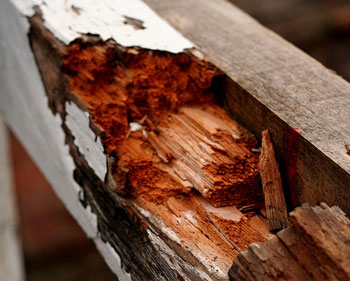Common Causes of Indoor Wood Decay
By Chris Williams on May 26, 2014.
 Wood decay or wood rot is not only a problem in itself, but it also contributes to insect damage. Insects that feed on, or nest in, wood often start their infestation in softer, decayed or damp wood.
Wood decay or wood rot is not only a problem in itself, but it also contributes to insect damage. Insects that feed on, or nest in, wood often start their infestation in softer, decayed or damp wood.
In any home, there will be uncountable fungal spores, waiting in dormancy for the high moisture level needed to germinate. When there is no moisture problem, a building is safe from decay. But once moisture appears in the wood from roof leaks, plumbing leaks, condensation, or other causes—the fungus begins growing.
Dry wood with a moisture content of 10-20% will not rot. Surface molds and mildew can grow on wood with a moisture content of 20-25%. Wood decay fungus is the final stage in wood deterioration and requires a wood moisture content of 25% or higher.
Roof Leaks
Roofs can leak in many places and for many reasons. Missing or damaged shingles are just one reason. Roof leaks also occur when flashing is missing or damaged around chimneys and dormers. Even slight leaks in these areas can produce serious decay problems because rainwater is concentrated in one area and wood thoroughly wetted after rain has little opportunity to dry. Wood decay from a leaky roof is often not found where you expect it. A leaky roof can direct water almost anywhere inside your house.
Plumbing Leaks
Wood that is wetted continuously by faulty plumbing will decay. Some plumbing leaks are quickly obvious and can be repaired right away. It’s the slow, hidden leaks that are a problem. Water accumulating behind a washing machine, leaks at the top of a built-in tub, missing grout in a shower stall, or a leak from a defective toilet seal may go unnoticed for a long time. As a result, by the time the leak is discovered there can be a serious decay problem in the floor and lower parts of interior walls.
Condensation Moisture
Tightly sealed homes are subject to high moisture levels, particularly in winter. Showering, washing floors or dishes, cooking, even breathing, all generate moisture vapor which can be high enough to cause mildew growth. The presence of continuous condensation, frost, or ice on windows is a sign of excess moisture.
Many houses are built over an enclosed crawlspace. Moisture from the soil beneath the house condenses on subfloor timbers, which can become wet enough to decay. This is more likely when ventilation is poor, the soil is particularly moist, or when vents in the perimeter walls are closed during the winter.
Crawlspace moisture is more of a problem Northeastern states like New Hampshire and Massachusetts where climatic conditions are more likely to cause condensation during winter months. There are two schools of thought these days as to whether such crawlspaces should be enclosed completely to keep moisture out, or should have additional ventilation installed to help dry the space.
Photo credit: Iain Cuthbertson / Foter / Creative Commons Attribution-ShareAlike 2.0 Generic (CC BY-SA 2.0)